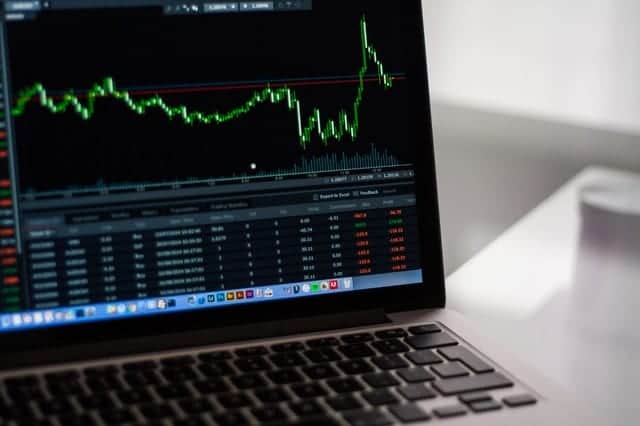
Momentum Investing: Trade Share Price, Not Valuation
Hi my name’s Nick Radge, Head of Trading and Research at The Chartist. At The Chartist we have several momentum investing strategies.
My best investment is Invocare the funeral operators, two things in life death and taxes, Invocare looks after one of those. My worst investment; I took a tip from a very good friend of mine, and in the space of about three weeks lost $35,000 and I’ve never taken a tip since.
Hello I’m Tony Featherstone, Consulting Editor of the ASX Investor Update eNewsletter, I’m here with Nick Radge, Head of Research and Trading at The Chartist, and author of the new book Unholy Grails: A New Road to Wealth. Nick has been an investor and trader for 26 years and worked in dealing rooms in Sydney, Singapore and London and he consults to stock broking, accounting and financial planning firms on money management matters. Now the purpose of our interview is three fold; first we’ll ask Nick to explain charting and how it works, then we’ll ask Nick to explain the style of charting he uses, which is known as momentum trading, and finally we’ll get Nick’s view on the Australian share market.
What is Charting?
Charting is the study of the market itself, rather than the companies that make up the market. So we look at things like price, we look at volume, we look at volatility. So charting seems pretty popular these days why are more people using it? Yeah charting has become a lot more popular because it’s much more of a timing tool. So fundamentals tell you what to buy and charting tends to tell you when to buy, so you can put them together nicely. So Nick to a lay person charting to me it almost seems too good to be true, so I look at a share price, I’m looking for patterns, I’m ignoring all the technical company info and broker reports and media stories and just looking at the chart, is it really as simple as that charting?
Price Analysis
The view is that charting or the market is fully pricing in the information we currently know, okay that’s the first thing, but the other thing to understand is the charting itself is not making the money, the money is made from the mathematics behind it, but charting gives us a reason to be involved and a reason to extract ourselves from the market. So it’s a much more of a comfort tool if you like. People find comfort with fundamental analysis and that’s one tool, we use technical analysis it’s just another tool.
So to summarise that I could use fundamental analysis to figure out what to buy and sell but charting could help me tell when to buy and sell it. That’s correct. So the problem with a lot of value investing, for example, is you have to wait until the value is realised, of the company that may take six weeks, it might take six months, and in some cases it might take years.
Time is money, so by using technical analysis we can help reduce that time factor and get us involved when the move comes along. So is charting just for traders or active investors, could a long term portfolio investor use charting as well? Absolutely you can use any time frame, so a lot of traders would use daily time frame, investors can use weekly and monthly time frames, absolutely.
The Myth of Prediction
Now Nick some people watching this video will say charting can’t possibly work, because the theory says that past share price performance can’t predict future performance, so why on earth would you use charting? So why does it work in your opinion? We’re not actually predicting, this is the big misconception, we don’t predict. The market is driven by sentiment of the players in the market itself and human sentiment, fear, greed, ego, everything is always the same, it has been for hundreds of years, and their actions create price patterns, it creates trends, and all we’re trying to do is say right we have a trend established, chances are it may continue and we just hop on board.
So really what you’re saying is charting a way of getting a snapshot of the market psychology? Correct, absolutely. So it’s quantifying how people are thinking about a stock? Absolutely. When think about, say when Warren Buffet comes into a stock, he has to come in with a lot of force, a lot of effort, and that will leave some kind of a market on the market whether it be in volume or price or whatever it is, and those foot prints if you like are what we try and look at and find out whether the smart money is coming into the stock and then we can take advantage of that.
Why Not Fundamental Analysis?
So Nick most people watching this video will use fundamental analysis in their investment decisions. So they’ll look at company information, they might read the annual report, the profit and loss statement, they might read the newsletter from their broker or the media report on the company, can you combine that style of investing with charting, and what would be the benefit of doing so? Absolutely. So what you would do is you would hone down a group of stocks based on the fundamentals, so you would find stocks that potentially are trading below their value or have some kind of growth potential in them, and then you would come to the charts and find out the best time to try and buy that.
Obviously when we’re investing the stock market we can only make money when the share price rises, okay we can’t make money if the share price goes sideways or down. So you can establish a group of companies that have strong fundamentals and then you could establish a point at which the share price starts rising that you could buy in, and then you would ride that rise.
Okay so Nick you favour a particular style of charting known as momentum trading, how does that work?
Momentum Investing
Look I’ve been doing that for 26, 27 years now. The best analogy I’ve come up with is like a hitchhiker. So we’re sitting here in Sydney today, let’s say we want to catch a ride or hitchhike to Brisbane, the first thing we’re going to do is go and stand in the north bound lane of the Pacific Highway, I’m tipping that if a car is going to Brisbane, it’s going to be in the north bound lane, not in the south bound lane. So we’re standing on the right side of the market to start with.
Then what happens we don’t know what car is going to stop to pick us up, like we don’t know what stock is actually going to go up at any particular period of time. But we do know if we stand on the side of the road for long enough a car will stop and we know if we stand on the side of the market a share price or a share will go up at some stage. So all we do is jump on to that.
Now the next thing to understand is we don’t know how far that ride will take us, if we hop on to a ride here it might take us to Newcastle, it might take us to Coffs Harbour, it might take us all the way the way to Brisbane, we don’t know that when we get on. And same when you get on a share price, we don’t actually know who far it’s going to go, but we do know if the ride changes or turns, we’ll hop off, and that’s all we do and eventually we get to our destination.
Stocks on the Move
It’s an interesting analogy isn’t it because you’re just looking for stock that’s going up; you’re going for the ride, if it’s not the right stock you get off. That’s exactly right, simple as that. As simple as that sounds that’s all we’re doing. Yeah I see lots of investors, particularly during market shocks, they’ll ride the stock all the way up, and then they’ll hold it all the way down and the share price starts to look like a tombstone.
That’s right. And it keeps going down and they’re thinking it will eventually come up and it doesn’t so it’s very important with the timing isn’t it? Absolutely, and it keeps you out of, it automatically keeps you out of those stocks that eventually may go bankrupt. You know think of the Babcock & Brown and those kind of stocks that during the GFC went to nothing. I mean even stocks that are still listed, but are so far off, think of Billabong, think of Telstra for many, many years that started at $7 went all the way down to whatever it got to, $2, $3 somewhere down there, and it’s only started going back up. We haven’t been involved in Telstra for years, but now we have been involved for one reason.
Cut Your Losses
So you’d identify points on the chart, where if it breaks that point you sell. Correct. And you cut your losses. Correct. And you’d identify points where if it goes above that point you’d buy. Absolutely, as simple as that. So to apply that philosophy to REA Group, which has the realestate.com website, and has done really well, how would momentum trading have worked for a stock like REA?
Well the point we would pick would be something like if the share price makes a new one year high, okay, if REA is trading at $5 and we – if it’s going to go to $40 well it has to go through $7 first, it has to go through $10 first, so we might say okay it’s trading at $5, if it goes up, not down, if it goes up to $7 it might be on its way a lot higher and we’ll jump on the ride. Conversely if it’s going down, well look it might come good eventually, but how long is that going to take, how long will our money be tied up for before it comes good? So all we’re doing is hopping on the ride when it moves.
Momentum vs Value
Nick one of the things I struggle a little bit with momentum trading is it seems to be the opposite to me of value investing, so when a stock is going up you’ll see brokers saying well it’s hit its fair value, and it’s becoming expensive time to take profits. And when it’s going down you often seen brokers saying that stock is getting cheaper. Yet with momentum trading you’re saying buy it when it’s going up and sell it when it’s going down, is there a risk that we could be buying stocks that are getting more and more expensive on the way up and selling stocks that are getting cheaper and cheaper on the way down? Well that’s a risk, but you have anchored yourself to expensive and cheap.
Isn’t a Stock Whose Price is Going Up Considered Expensive?
What is expensive and cheap? It’s nothing but really an opinion and that’s what it comes down to, I have no such anchor if you like, so if we have a look at that chart again of regroup, we can see that it was at $5 and went to $10 and went 15, 20, 25, 30 and all the time the valuations were going up following it along. So valuations are a fluid event themselves just like share prices are. We don’t make money from the valuation, we make money from the share price, so that’s what we’re trading, the share price up, not the valuation, the share price that’s what we’re moving. So could I be one of those investors who confuses price and value and bases their decisions on the chart.
So if it goes up it must be expensive, if it falls it must be cheap, so it’s very important to mix up that price and value isn’t it? That’s exactly right, it is complete opposites and that is difficult for some people, for example last year I gave a talk at the Australian Investors Association and I was talking about Commonwealth Bank, which at the time was at $60 and suggesting it was a great buy because the trend was up, and a lady stood up and said that’s crazy, you know it’s so overvalued, and here we are, Commonwealth Bank is up at $80, the trend remains up, we just don’t know. Valuations move, fundamentals of companies are fluid, they’re always changing, sometimes for the better, sometimes for the worst, but we make our money from what the share price is actually doing.
Exit and Hop off the Ride
So what could go wrong with your theory? I could be completely wrong, but if I’m wrong and the trend changes we hop off. And that’s the good thing about it. So during the GFC for example, because we don’t make any predictions we just get off the ride, during the GFC we were fully in cash by June, July 2008, and we just sat in cash, we didn’t predict the market was going to collapse, call us lucky, but the trend was definitely down and we waited then it turned up and we hopped back on again. So to use that great old share market saying, with momentum trading you let your profits run and you cut your losses. Absolutely, absolutely.
You’re Not Trying to Predict?
No prediction whatsoever. It’s a game of mathematics we play. So let’s say for example if I make 10 trades, and let’s say I only get five of those right, people will automatically think oh you’re not very good at this, but the five I get right if I make four times the amount of money, then what I lose on the five I get wrong mathematically I’m well ahead of the game and I’ll take that equation every day of the week.
Nick you realise there’s a multi-billion dollar industry out there trying to predict the share market and forecast stocks and value them in the future. In your view is that a bit futile? It is completely futile, but that’s what we’re brought up to do, you know that’s just human nature, that’s what people want, let’s call it ego whatever you like. You know I pick this one to go there and I pick that to go there, at the end of the day nobody knows what’s going to happen, absolutely nobody knows what’s going to happen.
Read Unholy Grails to Learn More About Momentum Investing
So finally Nick for investors who like the sound of charting and momentum investing, what should they do next to get started? Read the ebook Unholy Grails – A New Road to Wealth
Fantastic, Nick Radge thanks for your time.
Thanks Tony.
Published on 28 Sep 2014

